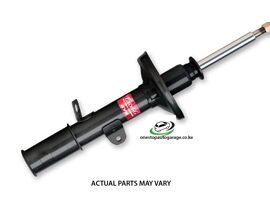-10%
Get Mazda Demio DY3 Front Shock Absorber Assy 333415 in Kenya
The front shock absorber assembly is a crucial component of a vehicle’s suspension system. It plays a vital role in maintaining stability, handling, and ride comfort. This component absorbs and dampens shocks from road irregularities, ensuring that the tires remain in contact with the road for optimal control. This document explores the structure, function, types, working mechanism, maintenance, and troubleshooting of the front shock absorber assembly.
Structure and Components
A front shock absorber assembly consists of several essential parts:
- Shock Absorber (Damper): Converts kinetic energy from road impacts into heat energy, which dissipates through hydraulic fluid or gas.
- Strut: A structural component that integrates the shock absorber with a coil spring, enhancing load-bearing capacity.
- Coil Spring: Absorbs major road shocks and works with the damper to reduce vibrations.
- Upper and Lower Mounts: Connect the shock absorber to the vehicle’s frame and wheel assembly.
- Piston and Cylinder: The piston moves through hydraulic fluid, providing resistance to sudden motion.
- Bushings and Bearings: Minimize noise and vibration, improving ride comfort and component longevity.
Function and Working Principle
The primary function of a front shock absorber assembly is to control unwanted motion and provide a smoother ride. The working principle involves:
- Compression Stroke: When the vehicle encounters a bump, the shock absorber compresses. The piston forces hydraulic fluid through small valves, creating resistance and absorbing energy.
- Rebound Stroke: As the suspension returns to its normal position, the fluid moves back, controlling the speed of return and preventing excessive oscillation.
- Heat Dissipation: The energy absorbed is converted into heat, which dissipates through the hydraulic fluid or gas.
Types of Front Shock Absorbers
There are various types of front shock absorbers, including:
- Twin-Tube Shock Absorbers: Comprise an inner and outer tube, allowing smooth fluid displacement and effective damping.
- Monotube Shock Absorbers: Have a single-cylinder design with a gas chamber, providing superior heat dissipation and performance.
- Gas-Charged Shock Absorbers: Use pressurized gas to reduce fluid aeration, preventing foaming and enhancing responsiveness.
- Adjustable Shock Absorbers: Allow manual or electronic adjustment of damping force to suit different driving conditions.
- Coilover Shock Absorbers: Integrate a coil spring over the damper, commonly used in performance and off-road vehicles.
Maintenance and Replacement
Regular maintenance of the front shock absorber assembly is essential for vehicle safety and comfort. Key maintenance practices include:
- Visual Inspection: Check for leaks, cracks, or signs of wear.
- Bounce Test: Push down on the front of the vehicle and release; excessive bouncing indicates worn-out shocks.
- Alignment and Tire Wear Check: Uneven tire wear may signal shock absorber issues.
- Lubrication of Mounting Points: Ensures smooth operation and reduces friction.
- Timely Replacement: Most shock absorbers last between 50,000 to 100,000 miles, depending on road conditions and driving habits.
Troubleshooting Common Issues
Common problems with front shock absorbers include:
- Leaking Hydraulic Fluid: Indicates worn-out seals or internal damage.
- Excessive Bouncing or Swaying: Suggests deteriorated damping ability.
- Clunking or Knocking Noises: May result from loose mounting bolts or damaged bushings.
- Poor Handling and Braking Performance: Failing shock absorbers can increase stopping distances and reduce steering control.
- Vibration in the Steering Wheel: Can be caused by worn-out shocks leading to poor road contact.
Conclusion
The front shock absorber assembly is a fundamental component of a vehicle’s suspension system, ensuring stability, comfort, and safety. Regular maintenance and timely replacement are essential to keep the suspension system functioning effectively. Understanding its working mechanism, types, and common issues helps vehicle owners and mechanics diagnose and resolve problems efficiently.
Follow us on Facebook for more parts.



